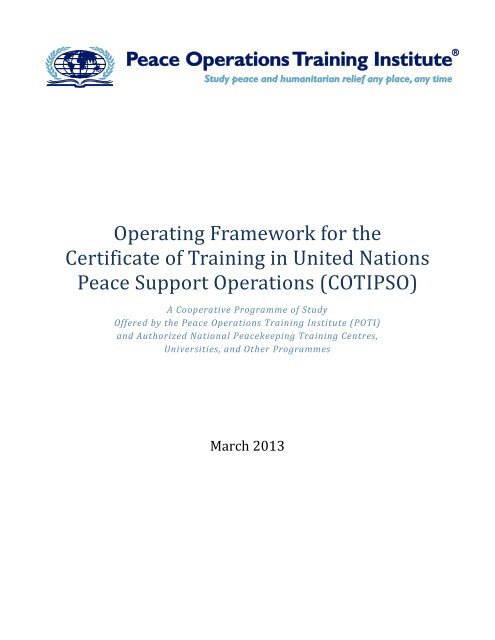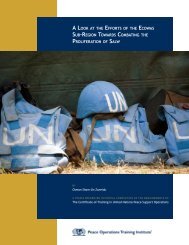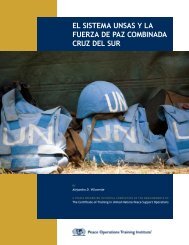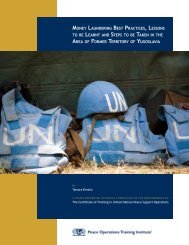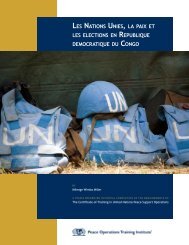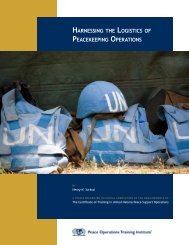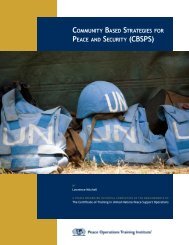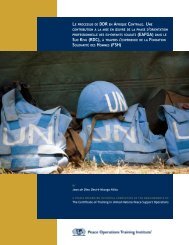COTIPSO Operating Framework (PDF) - Peace Operations Training ...
COTIPSO Operating Framework (PDF) - Peace Operations Training ...
COTIPSO Operating Framework (PDF) - Peace Operations Training ...
You also want an ePaper? Increase the reach of your titles
YUMPU automatically turns print PDFs into web optimized ePapers that Google loves.
<strong>Operating</strong> <strong>Framework</strong> for theCertificate of <strong>Training</strong> in United Nations<strong>Peace</strong> Support <strong>Operations</strong> (<strong>COTIPSO</strong>)A Cooperative Programme of StudyOffered by the <strong>Peace</strong> <strong>Operations</strong> <strong>Training</strong> Institute (POTI)and Authorized National <strong>Peace</strong>keeping <strong>Training</strong> Centres,Universities, and Other ProgrammesMarch 2013
<strong>Operating</strong> <strong>Framework</strong> for the Certificate of <strong>Training</strong> in UnitedNations <strong>Peace</strong> Support <strong>Operations</strong> (<strong>COTIPSO</strong>)1. AUTHORITYThis <strong>Operating</strong> <strong>Framework</strong> for the cooperative programme of study leading to theCertificate of <strong>Training</strong> in United Nations <strong>Peace</strong> Support <strong>Operations</strong> (<strong>COTIPSO</strong>) is promulgatedby the <strong>Peace</strong> <strong>Operations</strong> <strong>Training</strong> Institute (POTI). It shall be the purpose of this <strong>Operating</strong><strong>Framework</strong> to establish the procedures by which POTI and authorised national peacekeepingtraining centres, universities, and other training institutions shall form a cooperative programmefor the purpose of offering standardised training in peacekeeping. This programme shall beadministered by the Executive Director of POTI.2. PURPOSE OF THE COOPERATIVE PROGRAMME OF STUDYIt is the purpose of this cooperative programme of study to offer a training structure thatintegrates classroom training, distance training, and student research in the form of an originalthesis on a topic related to peacekeeping. This cooperative programme of study is designed to beuniversally available, flexible, and economical. A student who satisfactorily completes all threecomponents of the programme will be awarded the Certificate of <strong>Training</strong> in United Nations<strong>Peace</strong> Support <strong>Operations</strong>. The holder of this certificate will have demonstrated a thorough studyof peacekeeping, but the certificate will not be offered as a guarantee of employment with theUnited Nations.3. BACKGROUNDThe training of peacekeepers has always been a national responsibility and a nationalprerogative. The United Nations Department of <strong>Peace</strong>keeping <strong>Operations</strong> (DPKO) Integrated<strong>Training</strong> Service (ITS) issues training materials and guidelines for how peacekeeping trainingshould be conducted, but DPKO ITS is not responsible for the actual conduct and delivery ofpeacekeeping training.There are hundreds of peacekeeping related courses offered by more than 80 differentnations through their national training centres. These courses range from a few days to severalmonths. The classroom instructors are usually military personnel of the nation offering thecourse. Many of the resident programmes include some sort of exam and most award a certificateor other form of recognition for completion, but this varies between programmes. In most casesthe cost of the training is borne by the nation offering the courses, and in some cases foreignstudents are permitted to attend upon payment of an enrolment fee.In addition to the resident classroom courses offered by peacekeeping training centres,there are also classroom peacekeeping courses offered by other organisations. These includetraining and educational components within the UN system, courses held at colleges anduniversities specializing in UN-related studies, and courses conducted by NGOs and private notfor-profittraining (and research) facilities.POTI offers a programme of self-paced correspondence courses on peacekeeping.Students from 165 different nations study the course materials, submit an exam at the end ofeach course, and if they pass, receive a certificate of completion for each course.Page 1
4. INTEGRATION OF THREE TRAINING COMPONENTS: CLASSROOM TRAINING,DISTANCE TRAINING, AND INDIVIDUAL RESEARCHIt is the purpose of this cooperative programme of study to integrate classroom training,distance training, and individual research. Sections 5 through 7 below provide the standards andmethods for the administration of each component.5. CLASSROOM TRAININGClassroom training shall consist of approved courses conducted by training componentswithin the UN system, courses offered by regional or national peacekeeping training centres,courses held at colleges and universities specializing in UN-related studies, courses conducted byNGOs and private not-for-profit training (and research) facilities, and others as may beappropriate.5. a. Certification for Approval of a Classroom CourseAn organization offering a classroom course in peacekeeping or peacekeeping-relatedtopics that wishes to affiliate with POTI in the Certificate of <strong>Training</strong> in <strong>Peace</strong> Support<strong>Operations</strong> may contact the <strong>COTIPSO</strong> Coordinator and seek approval for the course ofinstruction. (See Appendix 1)The <strong>COTIPSO</strong> Coordinator of the Institute shall review the Application for Approval of aClassroom Course in consideration of the following criteria. The classroom course should covera topic or topics appropriate to peacekeeping or related to peacekeeping. The classroom courseshould offer an opportunity for students to have face-to-face discussions with classroom teachersand other students, to ask questions, to participate in simulations as appropriate, and to learnunder the supervision of an experienced instructor or instructors. There must be one SupervisingInstructor identified and his or her qualifications must be sufficient. There are no rigid timeminimums, but as a general guideline, a full-time course should be one to two weeks in duration;a semester-long university course should meet for approximately 10 weeks for approximatelythree hours per week. The course content should not contradict accepted UN doctrine, policy, orpractices. The provider of the classroom course should be prepared to make a statement that thestudent has satisfactorily completed the course requirements. This determination may be madebased on performance on a written exam, practical performance, direct observation, or othermethods as may be appropriate.It is recognised that national peacekeeping training centres (and other classroom trainingproviders) offer courses on a wide variety of peacekeeping-related topics and therefore thecontent and focus of each student’s resident experiences may differ. This is viewed as a strengthas each student will be free to specialize in a topic offered by an approved training centre whilestill completing the standard correspondence courses provided through distance training and thewritten thesis required of all students.The Certificate of <strong>Training</strong> that is awarded to the student upon completion of all threecomponents of the programme shall bear the name of the organization providing the classroomcourse, and the Supervising Instructor (or his/her organizational senior) shall sign the Certificateaccordingly. An example of the Certificate of <strong>Training</strong> is provided as part of Appendix 1.6. DISTANCE EDUCATIONParticipants in the programme may complete any 12 of the self-paced correspondencecourses from POTI. POTI promulgates a list of courses available and the categories from whichPage 2
students may choose their 12 courses. These courses each include their own end-of-courseexamination, for which the minimum passing score is 75 per cent, and students are required topass all the exams prior to completion of the programme and the awarding of the certificate ofcompletion. It is intended that students complete one correspondence course per month for 12months, but students are free to proceed at their own pace as long as all 12 courses are completedwithin a maximum of 24 months of the initial enrolment. The correspondence courses providethe opportunity for students to extend what they have learned in the classroom courses, studyindividual topics not conveniently available in lecture format, and make progress in their studiesat their own speed and based on their own ability. Students may begin their correspondencecourses at any time before or after the classroom course. A list of correspondence coursesavailable as of March 2013 is provided in Appendix 2, but this list will change as new coursesare introduced. For an updated list of courses available, contact POTI or view the Institute’swebsite at http://www.peaceopstraining.org.7. INDIVIDUAL STUDENT RESEARCH PAPERS: THE THESISAfter the completion of the resident classroom course or a minimum of six of the 12required correspondence courses, the student may begin working on the original thesisintegrating what he or she has learned. The thesis is to be written at the level of graduate collegeresearch and should demonstrate both a factual understanding of peacekeeping and an ability tosynthesize and discuss peacekeeping and related issues. A list of suitable topics is provided inAppendix 3, but students are encouraged to depart from this list with prior approval asdocumented in the Petition to Commence the Thesis, provided as Appendix 4 and discussedbelow.7. a. Petition to Commence the ThesisThere are three steps to the completion of the thesis requirement. First, the student mustdecide on a topic and then review the list of Thesis Advisers on the POTI website. Each ThesisAdviser on the POTI website has his or her area of expertise as well as an email address listed.The student should not contact the adviser until he or she has enrolled and paid the <strong>COTIPSO</strong>fee. Once there is an agreement between the Thesis Adviser and the student, the student shouldcomplete and submit the Petition to Commence the Thesis (see appendix 4). This will require theagreement and signature of a Thesis Adviser and the <strong>COTIPSO</strong> Coordinator. Once the Petition toCommence the Thesis has been approved by the <strong>COTIPSO</strong> Coordinator, the student willcommence work on the project and communicate with the Thesis Adviser as required. It isgenerally expected that the thesis will be completed within approximately one year or less but nomore than 18 months from the date of approval of the Petition to Commence the Thesis.Extensions can be granted by the <strong>COTIPSO</strong> Coordinator. It is important for students to remainin communication with both the Thesis Adviser and the <strong>COTIPSO</strong> Coordinator to satisfy therequirements for completion of the Certificate of <strong>Training</strong> in United Nations <strong>Peace</strong> Support<strong>Operations</strong>. Additionally, the <strong>COTIPSO</strong> Coordinator is available to help students and advisersthrough the process.7. b. Writing the Thesis and Obtaining ApprovalIn the second step, the Thesis Adviser will discuss the topic with the student, supervisethe development of the concept, and read the thesis for quality and merit. The Thesis Adviser andstudent may meet directly or may communicate by email, phone, or other means as appropriate.Page 3
The thesis will be written at a graduate level of writing. This includes a thorough reviewof the topic and where applicable a thesis statement that supports the paper’s main point.Additionally students will document all sources and include a reference section indicating thesources used. The paper will credit other authors where appropriate. The format used will be areadily acceptable form of documentation. This could be MLA, APA or CMS. Although there isnot a set length for the paper, in general, most papers exceed 25 pages double-spaced.When the student has completed writing the thesis, he or she will submit it to the ThesisAdviser for approval. The Thesis Adviser may take one of two actions: return it to the student forrecommended changes or forward it to the <strong>COTIPSO</strong> Coordinator (in both printed and computerreadableform) with a recommendation for acceptance. If the Thesis Adviser returns the thesis tothe student for recommended changes, this does not constitute rejection of the thesis or failure ofthe student. The student may resubmit a revised thesis to the Thesis Adviser for reconsiderationas many times as practical within the 18 months following approval of the Petition to Commencethe Thesis.7. c. Approval by the <strong>COTIPSO</strong> CoordinatorThe third step in the completion of the thesis requirement is the approval by the<strong>COTIPSO</strong> Coordinator. The <strong>COTIPSO</strong> Coordinator may take one of two actions:1. If the thesis is deemed to be adequate, the <strong>COTIPSO</strong> Coordinator will approve itand provide comments to the student through the Thesis Adviser. Both the<strong>COTIPSO</strong> Coordinator and the Thesis Adviser will sign the cover page toacknowledge approval. The Thesis will then be posted on the POTI websiteunless the student requests that the paper not be posted.2. The <strong>COTIPSO</strong> Coordinator may return the thesis to the Thesis Adviser foradditional work.The role of the <strong>COTIPSO</strong> Coordinator is to uphold the standards of the Institute. Thethesis shall be written in a language agreed upon by the student and the Thesis Adviser. If thethesis were written and approved in a language not known to the <strong>COTIPSO</strong> Coordinator, he orshe could invite the opinion of another qualified individual as appropriate. The Thesis Adviserwill be paid by the programme an amount of US$500 per student. This shall be payable on theapproval of the thesis by the <strong>COTIPSO</strong> Coordinator or at the expiration of the 18-monthmaximum time period for completion, whichever comes first.8. STUDENT POPULATION AND ADMISSIONS POLICYThe target student population for this programme is both military and civilians interestedin peacekeeping and peacebuilding. It is anticipated that this programme will be beneficial tonon-commissioned officers, UN Secretariat personnel, civilian police, employees of NGOs,diplomats, and others. This programme has an open admissions policy. Any individual whowishes to receive this training will be admitted, but there will be no effort to publicize theprogramme to individuals beyond the populations of peacekeepers, civilian police, diplomats,NGO employees, and other relevant organizations and professions.9. COSTS, FUNDING, AND FINANCIAL CONSIDERATIONSThis three-part programme is designed to be economical and affordable. Studentsattending approved classroom courses provided by national peacekeeping training centres orPage 4
other nationally sponsored courses may find that there are additional fees for their residenttraining. In some cases where there is a fee for classroom training, this is between the studentand the classroom training provider.In regards to cost of the 12 self-paced correspondence courses, students shall enrol andmake payment if applicable for each course, one at a time or in bulk, through their virtualclassroom. Course prices vary and depend on the students’ eligibility programme. All costsassociated with the supervision and review of the thesis and the Certificate of <strong>Training</strong> in UnitedNations <strong>Peace</strong> Support <strong>Operations</strong> shall be funded by a one-time payment of US$1,239. Thismay be paid by the student, a sponsoring organization, or a nationally sponsored programme asappropriate. Appendix 6 provides an allocation of costs.10. TIME REQUIREMENTS AND SCHEDULEThis programme is designed to be completed by students in approximately 24 months ofpart-time study, but the actual time needed for each student will vary. Timelines are providedbelow. Individual extensions of time requirements may be made by the <strong>COTIPSO</strong> Coordinator ofPOTI in response to specific student requests.A student may begin the programme at any time either by participation in an approvedclassroom course or by enrolling in the POTI self-paced correspondence courses. Students whobegin the programme by enrolling in a classroom course have six months to begin thecorrespondence courses. Students who begin with the correspondence courses have 24 months tocomplete an approved classroom course. Once the student has completed either the classroomcourse or six correspondence courses, he or she may begin the thesis process by submitting thePetition to Commence the Thesis. The thesis must be completed within 18 months of the date ofthe approval of the Petition to Commence the Thesis. Upon completion of all three componentsof the programme (classroom course, 12 distance-training courses, and thesis), the student shallsubmit a Petition for the Certificate (see Appendix 5). Once the Petition for the Certificate isreceived by POTI and a confirming determination has been made, the Certificate of <strong>Training</strong> willbe processed and sent directly to the student.10. a. Timelines:Beginning of the Programme:Students may begin the programme either by attending an approved classroom course orenrolling in the correspondence courses. Students beginning with the correspondence courseshave 24 months to complete an approved classroom course.Completion of the Correspondence Courses:The correspondence courses are designed to be completed at the rate of one per month for 12months. However, students may proceed at their own pace as long as they continue to makeprogress in the distance training courses. If no contact is made between the student and POTI for18 months, the programme could be terminated.Submission of the Petition to Commence the Thesis:Students may submit the Petition to Commence the Thesis after they have completed either theclassroom course or six correspondence courses.Page 5
Submission of the Thesis:It is estimated that the thesis will normally take approximately 12 months to complete. However,the thesis must be completed within 18 months of the date of the approval of the Petition toCommence the Thesis.Previously Taken Courses, Special Circumstances and Requests, and Granting of Variance:Students who have previously completed some of the requirements of this programme but whofall outside the established time schedules may request a Granting of Variance. Students whoneed a Granting of Variance from these time requirements for any reason may make a request byletter to the <strong>COTIPSO</strong> Coordinator of POTI.Maximum Allowable Time:This programme is designed to be completed in approximately 24 months for most students.However, if a student cannot meet the timeline due to professional, medical, or familyobligations, an extension may be granted by the <strong>COTIPSO</strong> Coordinator.11. RESPONSIBILITIES11. a. The studentThe student is responsible for obtaining admission to an approved classroom course andsatisfactorily completing the classroom course.The student is responsible for enrolling in 12 correspondence courses from POTI andpassing all 12 end-of-course exams with a minimum score of 75 per cent. The student isresponsible for contacting a POTI approved Thesis Adviser and proposing a suitable thesis topic,submitting the Petition to Commence the Thesis, writing the thesis under the supervision of theThesis Adviser, submitting the Thesis to the Thesis Adviser (normally in a computer-readableform) for approval, making any revisions as directed by the Thesis Adviser and resubmitting thethesis, and submitting the Petition for the Certificate once all programme requirements have beenmet.11. b. The Supervising Instructor of the Classroom CourseThe Supervising Instructor of the classroom course is responsible for supervising theteaching of the course but is not expected to teach every class. The Supervising Instructor of theclassroom course is responsible for assessing and reporting the student’s satisfactory completionto the <strong>COTIPSO</strong> Coordinator of POTI. The Supervising Instructor shall either sign theCertificate of <strong>Training</strong> or arrange for signature by a more senior individual.11. c. The Thesis AdviserThere will be as many Thesis Advisers as may be appointed by the <strong>COTIPSO</strong>Coordinator. A Thesis Adviser will normally hold a minimum rank of Lieutenant Colonel orCommander, hold a comparable civilian rank, or hold an advanced university degree. The ThesisAdviser is responsible for supervising the student as the student writes the thesis. This willinclude communicating with the student when the student proposes the concept; eitherforwarding the student’s Petition to Commence the Thesis with a favourable recommendation orreturning the petition to the student for revision; communicating with and mentoring the studentas needed during the development of the thesis; reading drafts and offering suggestions; readingthe submitted thesis for quality and merit; and either forwarding it to the <strong>COTIPSO</strong> CoordinatorPage 6
with a favourable recommendation or returning it to the student for revisions. The ThesisAdviser shall be available to the student by email, phone, fax, post, or direct meeting until thethesis is approved or the 24-month maximum time allowed for completion is reached. OneThesis Adviser may supervise multiple students. Thesis Advisers report to the COTISPOCoordinator.11. d. The <strong>COTIPSO</strong> CoordinatorThere shall be one <strong>COTIPSO</strong> Coordinator, who is appointed by and reports to theExecutive Director of POTI. In the absence of an appointed <strong>COTIPSO</strong> Coordinator, theExecutive Director of the Institute shall serve this role. The <strong>COTIPSO</strong> Coordinator shall recruit,evaluate, appoint, and terminate Thesis Advisers. The <strong>COTIPSO</strong> Coordinator shall reviewPetitions to Commence the Thesis and may either approve them or return with modifications.The <strong>COTIPSO</strong> Coordinator shall review theses that have been favourably recommended byThesis Advisers and either approve or return them to the Thesis Advisers for student revision.The <strong>COTIPSO</strong> Coordinator shall see that approved theses are posted on the web and availablefor public examination. The <strong>COTIPSO</strong> Coordinator also reviews various programmes ofinstruction offered by national peacekeeping training centres, universities or other organizationsoffering resident classroom instruction. The <strong>COTIPSO</strong> Coordinator will approve the variouscourses for affiliation or partnership with POTI.11. e. Executive Director of POTIThe Executive Director of POTI shall be responsible for the operation of the cooperativeprogramme of study under the terms of this <strong>Operating</strong> <strong>Framework</strong>. The Executive Director of theInstitute shall supervise the programme, appoint and terminate the <strong>COTIPSO</strong> Coordinator,approve or disapprove Applications for Approval of a Classroom Course, confirm a student’scompletion of the three components to the cooperative programme of study, coordinate with thedirectors of the various providers of classroom training, sign the Certificates of <strong>Training</strong>, obtainconfirming signatures on the Certificate of <strong>Training</strong> from the Supervising Instructor of theClassroom Course, and award the Certificate of <strong>Training</strong> in United Nations <strong>Peace</strong> Support<strong>Operations</strong>.Page 7
Appendix 1: Application for Approval of a Classroom CourseThis application shall be used by educational/training components within the UN system,regional or national peacekeeping training centres, colleges and universities specializing in UNrelatedstudies, NGOs and private not-for-profit training (and research) facilities, and others toapply for approval of a classroom course to meet the classroom-course requirement of thecooperative programme of study leading to the Certificate of <strong>Training</strong> in United Nations <strong>Peace</strong>Support <strong>Operations</strong>. Approval is normally for a five-year period and may be renewed.This cooperative programme of study requires that the student complete threecomponents: an approved classroom course, 12 self-paced correspondence courses, and anoriginal thesis written by the student. It is the purpose of this Application for Approval of aClassroom Course to provide for a review and approval (or disapproval) of a proposed classroomcourse as a recognized part of the cooperative programme of study.Once a student completes all three components of this programme, she or he will beawarded the Certificate of <strong>Training</strong> in United Nations <strong>Peace</strong> Support <strong>Operations</strong>. This Certificateshall bear two signatures, one of which is the Supervising Instructor or other representative of thestudent’s organization, and the other is that of the Executive Director of POTI. An example ofthe Certificate is provided with this application.This form may be used to request approval of either a single classroom course or multipleclassroom courses. If approval is being requested for multiple classroom courses, please becareful to indicate separately each course’s information, such as Supervising Instructor, courseduration, and number of meetings.Please answer the questions below, either in the space provided or on a separate sheet ofpaper as needed, and mail it to the <strong>Peace</strong> <strong>Operations</strong> <strong>Training</strong> Institute, 1309 Jamestown Rd.Suite 202, Williamsburg, VA 23185, USA.1. Name of organization offering classroom course and requesting approval:2. Mailing address of organization and website (if applicable):3. Name of course for which approval is being requested and a short summary of the course and some specificinformation (for example, the lessons, the hours for each lesson and the total number of days for the course):4. Name of Supervising Instructor for the course (and mailing address if different from address of organization):5. Phone and fax numbers of Supervising Instructor for the course (include all country and city codes):6. Email of Supervising Instructor and Internet web home page (if appropriate):Page 8
7. The dates for the course in a calendar year:8. Language in which the course is conducted:9. In the space below please provide any additional information as may be appropriate to convey a fullerunderstanding of the content, focus, scope and delivery of the course, or attach additional information asappropriate:10. Please attach a copy of the syllabus of the course. Any length of syllabus is acceptable, but in general a one- ortwo-page listing of topics should be sufficient. It is not necessary to include individual lesson plans.11. Supervising Instructor signature and date of submission:I hereby submit this Application for Approval of a Classroom Course for the named classroom course to be approvedas meeting the classroom course requirement leading to the Certificate of <strong>Training</strong> in United Nations <strong>Peace</strong> Support<strong>Operations</strong>.Signature of Supervising InstructorDatePage 9
The <strong>Peace</strong> <strong>Operations</strong> <strong>Training</strong> Institutein cooperation withthe Name of the <strong>Training</strong> Centreawards thisCertificate of <strong>Training</strong>in United Nations <strong>Peace</strong> Support <strong>Operations</strong>toName of Studentfor successful completion ofTwelve distance-learning courses from the <strong>Peace</strong> <strong>Operations</strong> <strong>Training</strong> Institute;An approved classroom course atthe Name of the Resident Course Provider in City, Country; andAn original graduate-level thesis, titledThesis Name._________________________Name, Title<strong>Peace</strong>keeping <strong>Training</strong> Centre Name_________________________Harvey J. Langholtz, Ph.D., Executive Director<strong>Peace</strong> <strong>Operations</strong> <strong>Training</strong> InstituteDate
Appendix 2: Self-Paced Correspondence Courses Available from POTI asof 1 March 2013AN INTRODUCTION TO THE UNITED NATIONS SYSTEM: ORIENTATION FOR SERVING ON A UNITEDNATIONS FIELD MISSION[In English, Arabic, French, Portuguese, and Spanish]This course should provide the student with an adequate base of the following topics: the purpose and principles of theUN, its system, and its institutional framework; the UN’s roles in the areas of peace, security, and development;applications of international humanitarian law and human rights; application of communication, negotiation, andmediation techniques; issues regarding safety and security; and general obligations and responsibilities of the FieldOperator. The objectives of the course are based on the policies and principles of the UN, as well as similar objectives asexpressed by organizations/institutes and NGOs. This course also entails the compilation and development of informationthat focuses entirely on the civilians assigned to UN field missions. Nine lessons, 220 pages.COURSE AUTHOR: LTC Christian Hårleman, Army of Sweden, Retired and former Chief of <strong>Training</strong>, UN Department<strong>Peace</strong>keeping <strong>Operations</strong>. Served on UN Missions in Latin America, Africa, Asia, Europe, Middle East.UNITED NATIONS CIVIL-MILITARY COORDINATION (UN-CIMIC)[In English, French, and Spanish]United Nations Civil-Military Coordination (UN-CIMIC) provides the interface between the military component of a UNpeace operation and the political, humanitarian, developmental, human rights, and rule-of-law components of the mission,as well as many other external partners in the larger peacebuilding system. It is a crucial function of any complex peaceoperation because it is central to the mission’s achieving a system-wide impact on the conflict it is attempting totransform. UN-CIMIC officers must understand the role and functions of a broad variety of development andpeacebuilding actors in order that they facilitate and coordinate the support that the peacekeeping force can provide toothers in the mission, non-mission actors, and the local community, as appropriate. Based on the 2010 UN-CIMIC Policy,this course introduces UN-CIMIC to military officers who have been assigned this function – though all military andcivilian students will find this course useful as it will improve their understanding of the institutional cooperation thatneeds to occur between mission components, and between the mission and the rest of the system, in order to ensure asustainable peace process. Nine lessons, 270 pages.COURSE AUTHORS: Cedric de Coning, Joint Research Fellow at ACCORD and NUPI, served previously as a trainingofficer at DPKO ITS and as a political and civil affairs officer with UNTAET; Christopher Holshek is an internationalpeace and security consultant focusing on civil-military relations in policy and practice as well as peace operations relatedcivil-military training and education. He is also a retired U.S. Army Civil Affairs Colonel.COMMANDING UNITED NATIONS PEACEKEEPING OPERATIONS[In English, Arabic, French, Portuguese, and Spanish]This course was designed for military, police, and civilian students who may find themselves in leadership positions inpeacekeeping operations, or for those wishing to understand the issues associated with commanding peacekeepingoperations. It is useful for participants at the strategic, operational, or tactical level, and for senior and junior leaders onpeacekeeping operations. Topics include UN Organs and Agencies, the Development of <strong>Peace</strong>keeping <strong>Operations</strong>, the UNCharter, Definitions of <strong>Peace</strong>keeping, Status of Forces, the UN Department of <strong>Peace</strong>keeping <strong>Operations</strong>, <strong>Peace</strong>keepingDoctrine, UN Police, Selection and Preparation of Leadership, Regional Organizations, Sustainability and LogisticalSupport Requirements, MOUs, Contingent-Owned Equipment, Command and Control, Civil-Military Coordination,NGOs, Security, SOPs, National Contingents, Tactical Techniques for Military Commanders, Observation Posts, Patrols,Checkpoints, Convoy Escorts, Rules of Engagement, Code of Conduct, List of Acronyms, and other support material. Thecourse also faithfully reproduces primary documents such as the Model SOFA and Model MOU, an UNMIL Soldier’sPocket Card that contains the Rules of Engagement, patrol reports, and other support material. Nine lessons, 327 pages.COURSE AUTHOR: Major General Tim Ford, Royal Australian Army, Retired, Former Head of Mission, UNTSO, andformer Military Adviser to the Secretary-General.Page 11
THE CONDUCT OF HUMANITARIAN RELIEF OPERATIONS[In English, French, and Spanish]Students learn how humanitarian relief is provided to refugees and victims of war and natural disasters. Topics include ahistory of humanitarian relief, the development of humanitarian action in the 20th century, international humanitarianorganizations, specialized government structures, NGOs, the Red Cross, principles of intervention, respect for at-riskpopulations including women and children, international humanitarian law, management of humanitarian emergencies,population security and safety, managing a refugee camp, community health care in humanitarian intervention, control ofcommunicable diseases and epidemics, relief convoys, shelter, distribution of food aid, water management, collectivesanitation, sustainable solutions to humanitarian crises, freely consented repatriation, asylum, conducting elections,establishment of civil institutions, the humanitarian charter, minimum standards for disaster relief, and code of conduct inrescue and disaster situations. A directory of humanitarian-related Internet sites is also included. Eleven lessons, 208pages.COURSE AUTHOR: M. Yvan Conoir, MBA and a Graduate in Political Sciences, has 20 years’ experience inHumanitarian relief operations, DDR, Reconstruction, and <strong>Peace</strong>building, as well as Capacity building and <strong>Training</strong>programmes with UNHCR, UNICEF, CARE Canada, CECI, the Pearson <strong>Peace</strong>keeping <strong>Training</strong> Centre and the <strong>Peace</strong><strong>Operations</strong> <strong>Training</strong> Institute in Africa, Asia, Central America, the Balkans, and Canada.DISARMAMENT, DEMOBILIZATION, AND REINTEGRATION (DDR): PRINCIPLES OF INTERVENTIONAND MANAGEMENT IN PEACEKEEPING OPERATIONS[In English, Arabic, French, and Spanish]The aim of the Disarmament, Demobilization, and Reintegration (DDR) process is to contribute to security and stability inpost-conflict situations so that recovery and development can begin. The DDR of ex-combatants is a complex process,with political, military, security, humanitarian, and socioeconomic dimensions. It aims to deal with the post-conflictsecurity problems that result from ex-combatants’ being left without livelihoods or support networks – other than theirformer comrades – during the critical transition period from conflict to peace and development. This course will help UNand national decision-makers, as well as UN, national, and NGO practitioners, to understand the aims, objectives, andpractical issues related to a DDR process. It will present different policies and strategies for the development,management, and evaluation of a DDR programme based on the International DDR Standards (IDDRS), whichconsolidate over 15 years of UN lessons and good practices on DDR issues. Eleven lessons, 316 pages.COURSE AUTHORS: The Inter-Agency Working Group on DDR, consisting of 15 UN departments, agencies, funds,and programmes, was established by the United Nations Executive Committee on <strong>Peace</strong> and Security with a mandate toimprove UN performance in DDR. The Working Group publishes the Integrated DDR Standards, a set of policies,guidelines, and procedures for UN-supported DDR programmes in the context of peacekeeping. This course was adaptedfrom the Integrated DDR Standards by Yvan Conoir.ETHICS IN PEACEKEEPING[In English, French, and Spanish]This course provides a basic overview and creates an understanding of the Ethics in <strong>Peace</strong>keeping. Through case studiesand practical examples, this compilation serves as a guide for peacekeepers in the field and provides some perspectivesconcerning the major aspects of modern-day peacekeeping from an ethical point of view. Topics include the Code ofConduct; Cultural Awareness; Gender and <strong>Peace</strong>keeping; SEA and Human Trafficking; Child Protection; Human Rights;HIV/AIDS Awareness; and UN Guidelines and Procedures on Discipline. Eight lessons, 132 pages.COURSE AUTHOR: The late Lt Col Michael McDermott, former <strong>Training</strong> Officer at DPKO ITS.GENDER PERSPECTIVES IN UNITED NATIONS PEACEKEEPING OPERATIONS[In English, French, and Spanish]This course addresses the conceptual and operational issues involved in integrating a gender perspective intomultidimensional peace operations. It describes the problems related to gender within contemporary armed conflict bycontextualizing the evolution of gender relations within the history of world conflict. The course also explores manyimportant concepts such as gender equity, gender balance, and gender equality, along with several underreported realitiesof conflict, such as sexual violence against males and sexual exploitation and abuse committed by UN peacekeepers.Page 12
Invoking the various UN and non-UN instruments of human rights and gender equality, the course emphasizes the needfor women to play a strategic role in all levels of decision-making in regional, national, and international institutes andmechanisms. Seven lessons, 264 pages.COURSE AUTHOR: Ximena Jimenez, BS, MA, MSc. International Gender, Women, <strong>Peace</strong>, and Security Consultant tothe UN, the Club of Madrid, and other international organizations and universities.HISTORY OF UNITED NATIONS PEACEKEEPING OPERATIONS DURING THE COLD WAR: 1945 TO1987[In English, French, and Spanish]This course provides students with an understanding of the genesis, origin, evolution, functioning, and effectiveness ofUN peacekeeping during the Cold War. It covers the Arab-Israeli conflict and missions in Korea, Lebanon, the Congo,India and Pakistan, the Middle East, Cyprus, and Africa. Military peacekeeping is discussed as a means to promote thepeaceful settlement of disputes. Eleven lessons, 206 pages.COURSE AUTHOR: Professor Sunil Ram, Canadian Forces Ret; based in part on the original course by the late Mr. F.T.Liu, former UN Assistant-Secretary-General for Special Political Affairs.HISTORY OF UNITED NATIONS PEACEKEEPING OPERATIONS FOLLOWING THE COLD WAR: 1988TO 1996[In English, French, and Spanish]This course traces the resurgence and subsequent retrenchment of UN peacekeeping and peace enforcement during theyears following the Cold War, discussing both the successes and the failures. It covers the operations in the Persian Gulf,Yugoslavia, Somalia, Rwanda, Mozambique, Angola, Cambodia, and Central America. Eleven lessons, approximately325 pages.COURSE AUTHOR: Professor Sunil Ram, Canadian Forces Ret; based in part on the original course by the late Mr. F.T.Liu, former UN Assistant-Secretary-General for Special Political Affairs.HISTORY OF UNITED NATIONS PEACEKEEPING OPERATIONS FROM RETRENCHMENT TORESURGENCE: 1997 TO 2006[In English, French, and Spanish]This course traces the retrenchment of UN peacekeeping operations in the late 1990s and early 21 st Century, which led toa growth in the size, scope, and complexity of new and existing UN peacekeeping and peace-enforcement operations. Thecourse covers operations in Haiti, Guatemala, the Balkans, and Africa. Eight lessons, 330 pages.COURSE AUTHOR: Professor Sunil Ram, Canadian Forces Ret.HUMAN RIGHTS[In English]This course is a comprehensive historical overview of the theory and practice of human rights, a term used to describerights and entitlements that inherently belong to every human being. Although all human beings are entitled to these rightsequally, history has shown that all people do not enjoy the same protection of their rights at all times. This course exploresthe different kinds of human rights, the various international and regional documents necessary to protect and enforcethem, and the historical difficulties and conflicts that have occurred in spite of, and often because of, human rights. Itincludes extensive discussions on the development of the various human rights treaties and enforcement mechanisms, thespecial protection given to vulnerable groups, human rights during armed conflict, and current debates involving humanrights, such as the use of technology either to promote or restrict human rights, and the increasing internationalsignificance of stateless actors like transnational corporations and terrorist groups. Fifteen lessons, 356 pages.COURSE AUTHOR: Jessica C. Lawrence, J.D.HUMAN RIGHTS AND PEACEKEEPING[In English]This course examines the cross-cutting principles and obligations concerning human rights within the specific context ofarmed conflicts and UN peace operations. Human rights is a dimension that transcends all phases and employs allPage 13
components of a peace operation, leading to often complex implementation planning and coordination, which this coursetraces and delineates. The course begins by reviewing the landmark documents and instruments indispensable to theprotection of human rights in theory, before demonstrating how such protection is enforced and performed on the ground.It discusses the various types of human rights violations, identifies the groups of people especially at risk, and conducts athorough analysis of the concept of protection – the core of human rights work in peace operations. The course containsimportant sections on human rights partners – a group that includes such external actors as NGOs and internationalbusinesses – and on the process of accountability, which, as the course demonstrates, is essential in peace operations if anestablished peace is to be long-lasting and sustainable. Ten lessons, 284 pages.COURSE AUTHOR: Patrick Marega Castellan is a human rights consultant who has served in various capacities –including specialist, adviser, and trainer – for UN missions in Haiti, Darfur, Angola, and Liberia. From 2006 to 2009, heserved in the Methodology, Education and <strong>Training</strong> Section of OHCHR, providing advice to OHCHR staff anddeveloping human rights training material in collaboration with DPKO. He is based in Papua New Guinea.IMPLEMENTATION OF SECURITY COUNCIL RESOLUTION 1325 (2000) IN AFRICA[In English]Security Council resolution 1325 (2000), unanimously adopted in October 2000, sets out a policy framework for womenand peace and security. This course, much like its sister course, Implementation of Security Council 1325 (2000) in LatinAmerica and the Caribbean, introduces the main principles of the resolution and provides practical guidelines on how toimplement it at the national level, including through the development of national action plans. While informative for anystudent interested in the topic, the course was especially designed for people who work at the highest decision-makinglevels, especially at the national level, in Africa and who require a practical tool to support and facilitate theimplementation of SCR 1325 (2000). The course is based on background information, analysis, and a wide range ofstudies. The first three lessons focus more broadly on the issues of women, peace, and security; the UN's role and viewson the subject; and SCR 1325 (2000) itself. Within this context, Lessons 4 and 5 highlight the challenges and prioritiesspecific to the African region. Lesson 6 examines the role of both regional and subregional organizations in supportingnational implementation of the resolution. The final lesson provides guidelines for creating and implementing a nationalaction plan. Seven lessons, 244 pages.IMPLEMENTATION OF SECURITY COUNCIL RESOLUTION 1325 (2000) IN LATIN AMERICA AND THECARIBBEAN[In English]Security Council resolution 1325 (2000), unanimously adopted in October 2000, sets out a policy framework for womenand peace and security. This course introduces the main principles of the resolution and provides practical guidelines onhow to implement it at the national level, including through the development of national action plans. While informativefor any student interested in the topic, the course was especially designed for people who work at the highest decisionmakinglevels, especially at the national level, in Latin America and the Caribbean and who require a practical tool tosupport and facilitate the implementation of SCR 1325 (2000). The course is based on background information, analysis,and a wide range of studies. The first three lessons focus more broadly on the issues of women, peace, and security; theUN's role and views on the subject; and SCR 1325 (2000) itself. Within this context, Lessons 4 and 5 highlight thechallenges and priorities specific to the Latin American and Caribbean region. The final lesson provides guidelines forcreating and implementing a national action plan. Six lessons, 221 pages.INTERNATIONAL HUMANITARIAN LAW AND THE LAW OF ARMED CONFLICT[In English, French, Portuguese, and Spanish]This high-level course covers International Humanitarian Law as applied to soldiers, humanitarian workers, refugees,displaced persons, and others involved with armed conflict. Topics include background and definitions, protection ofvictims, rights of prisoners of war, rules of conduct in hostilities, means of implementation, human rights and IHL,applicability of IHL to peacekeeping and peace enforcement, different applications to international and intra-nationalconflicts, terrorism, sovereignty, and the role of the International Red Cross in International Humanitarian Law. Written ata higher level than other <strong>Peace</strong> <strong>Operations</strong> <strong>Training</strong> Institute courses, this course deals with complex legal and militaryissues. Eight lessons, 129 pages.Page 14
COURSE AUTHOR: Mr. Antoine Bouvier, Legal Adviser in the International Committee of the Red Cross AdvisoryService on IHL, Geneva.LOGISTICAL SUPPORT TO UN PEACEKEEPING[In English, French, and Spanish]This course introduces students to logistics operations in UN peace operations. This basic course gives the backgroundand rationale behind United Nations <strong>Peace</strong>keeping logistics, the strategy employed in the field and at Headquarters,introduces the mission life cycle, explains how financial support is gained, and introduces the different components thatmake up integrated logistics support in a field mission. Eight lessons, 248 pages.COURSE AUTHOR: Mr. Kamran Baig, Coordinator of Common Services at the UN Office at Nairobi (UNON), formerlyserved at ONUB, UNMIL, UNLB, and UNMIBH.OPERATIONAL LOGISTICAL SUPPORT OF UN PEACEKEEPING: INTERMEDIATE LOGISTICS [InEnglish, French, and Spanish]This course provides the student with a background in intermediate-level topics of UN Operational Logistics. Topicsinclude an overview of UN operational logistics, command and control, planning, supply, engineering support, fireprotection, environmental measures, transportation, aviation and air services, maintenance, medical aspects of logisticalsupport, communications, and postal and courier services. Ten lessons, 182 pages.COURSE AUTHOR: Major Don Leslie, Canadian Forces, Ret.ADVANCED TOPICS IN UN LOGISTICS: THE PROVISION OF TROOPS AND CONTINGENT-OWNEDEQUIPMENT (COE) AND THE METHOD FOR REIMBURSEMENT[In English, French, and Spanish]The purpose of this Advanced Logistics course is to provide students with an in-depth look at the provision of, andreimbursement for, troops and equipment that troop contributing nations provide to UN peacekeeping missions. Theprimary reference is the UN COE Manual, and for ease of reference the lessons follow the same sequence as the manual.Students will understand what the COE system was designed to achieve and the rationale behind its creation. Topicsinclude standard elements of COE, verification, transportation, loss and damage, rates, and responsibilities. Referencesinclude glossary of terms, rate tables, and a sample MOU. Ten lessons, 158 pages.COURSE AUTHOR: Major Don Leslie, Canadian Forces, Ret.MINE ACTION: HUMANITARIAN IMPACT, TECHNICAL ASPECTS, AND GLOBAL INITIATIVES[In English, French, and Spanish]This course addresses the global problem of landmines and how international organizations approach the problem. Topicsinclude the Anti-Personnel Mine Ban Treaty (Ottawa MBT); mine action guidelines for ceasefires and peace agreements;landmine and UXO safety training; identifying landmines and UXOs; International Mine Action Standards (IMAS) andguidelines for application; victim assistance; mine risk education; UNICEF mine action strategy; mine information; mineaction assessment; and the electronic mine action network. Seven lessons, 272 pages.COURSE AUTHORS: Mr. Martin Donoghue, UN Mine Action Service, and Mr. Adrian Wilkinson, Geneva InternationalCentre for Humanitarian Demining (GICHD).PEACEKEEPING AND INTERNATIONAL CONFLICT RESOLUTION[In English, French, and Spanish]The overall aim of this course is to provide the student with a basic understanding of the field of Conflict Resolution andits application – both theoretically and practically – to peacekeeping intervention in contemporary international conflicts.Topics include the nature of conflict, key concepts of conflict resolution, contemporary conflict dynamics, conflictmapping, early warning and conflict prevention, peacekeeping and conflict resolution in war zones, peace settlements andpost-conflict peacebuilding, the role of culture in conflict resolution, and gender issues. Includes lesson exercises andparticipation in POTI’s online message board. Ten lessons, 216 pages.COURSE AUTHORS: Professor Tom Woodhouse and Dr. Tamara Duffey, Centre for Conflict Resolution, Department of<strong>Peace</strong> Studies, University of Bradford, UK.Page 15
PREVENTING VIOLENCE AGAINST WOMEN AND GENDER INEQUALITY IN PEACEKEEPING[In English]Gender inequality and violence against women affect the lives of every person, regardless of age or gender. This courseaims to assist peacekeeping personnel to promote the human rights and security of women and girls. It does so throughlessons emphasizing the nature and scope of violence against women and girls around the globe and the connectionsbetween gender inequality and violence in both public and domestic spaces, as well as on interpersonal, community,national, regional, and international levels. Other lessons cover women's rights as human rights and the international UNmandate to involve women in key roles within peacemaking and peacebuilding processes at every stage and every level ofauthority. Readings and case studies provide examples to assist peacekeeping personnel with considering how they, asindividuals and as teams, can work to promote gender equality and to change the attitudes and behaviours that perpetuateviolence. Ten lessons, 310 pages.COURSE AUTHORS: AnnJanette Rosga, Ph.D., in association with Megan Bastick and Anja Ebnöther of the GenevaCentre for the Democratic Control of Armed Forces (DCAF).PRINCIPLES AND GUIDELINES FOR UN PEACEKEEPING OPERATIONS[In English]This course is based on the internal DPKO/DFS publication titled United Nations <strong>Peace</strong>keeping <strong>Operations</strong>: Principlesand Guidelines, which is more widely known under its informal name, the Capstone Doctrine. This publication is acomprehensive document that defines and promulgates available peacekeeping doctrine, definitions, procedures, andpolicy. In 10 chapters, it introduces the concept and evolution of UN <strong>Peace</strong>keeping, explains the decision process thatprecedes the deployment of a peacekeeping operation, and then the planning process to implement that decision. It alsodiscusses the art of successful mandate implementation and addresses the management of peacekeeping operations, howoperations are supported and sustained, and how they are concluded at their termination. The Institute’s course is designedto teach this DPKO doctrine to all UN personnel serving in the field and at Headquarters, as well as to those who are newto UN peacekeeping. Ten lessons, 208 pages.PROTECTION OF CIVILIANS[In English]The protection of civilians is now a recurrent theme in peacekeeping mandates. Yet, while much academic work has beendone to highlight the issue, little doctrine or guidance has been produced. This course seeks to address some of that deficitby providing a historical perspective as well as suggesting some practical options for consideration by those undertakingthis task. Consisting of five lessons, the course begins by discussing the contemporary operating environment forpeacekeepers and how the changing nature of conflict necessitates the protection of civilians. In order to actualize thisrather ambiguous concept, the author then explores the legal basis and mandates that have been produced on protectionand outlines the threats that peacekeepers face. The course then turns to look at the current guidance and the variousstakeholders and ends with a look at the key principles of protection and how they can effectively be put into practice.Five lessons, 98 pages.COURSE AUTHOR: Colonel Robert Manton (Retd), of the Royal Australian Army, served as the Military Adviser toAustralia’s Ambassador to the United Nations from 2007 through 2011.UNITED NATIONS MILITARY OBSERVERS: METHODS AND TECHNIQUES FOR SERVING ON A UNOBSERVER MISSION[In English, French, Portuguese, and Spanish]This course will assist in training Military Observers by enhancing the general understanding of peacekeeping and byproviding specific knowledge of methods and techniques for serving on a United Nations mission. Beginning with astrategic overview of the United Nations organization, the course moves through the operational spectrum of theDepartment of <strong>Peace</strong>keeping <strong>Operations</strong> and ends at the tactical level of “on the ground” knowledge and skills requiredfor an individual MILOB to succeed. Thirteen lessons, 254 pages.COURSE AUTHOR: Phyllis J. Mihalas, Ph.D., Lieutenant Colonel (Retired), U.S. Army, Civil Affairs, served as theG5/CIMIC and Commander, Contingent #4, U.S. Military Observers to UNMEE.Page 16
UNITED NATIONS POLICE: RESTORING CIVIL ORDER FOLLOWING HOSTILITIES[In English, French, and Spanish]This course familiarizes the student with the roles and duties of UN Police in restoring civil order following hostilities.Topics include the UN and the UN Charter, a history of UNPOL operations, privileges and responsibilities, staff duties,reporting, liaison, negotiation, mediation, the use of interpreters, administrative matters, logistics, security and safety,hijacking, detainment, mines, sniper fire, first aid, communications, radio procedures, driving, and various referencematerials. Nine lessons, 186 pages.COURSE AUTHORS: Detective Chief Inspector Peter Heepen, German State Police, UNPOL Monitor UN IPTF Bosnia-Herzegovina and OSCE Kosovo Verification Mission; and Colonel Guenther Freisleben, German State Police, formerlyEU Police Mission in Bosnia-Herzegovina and Chief Adviser in the Republika Srpska, Head of the State Police CollegeWertheim.Page 17
Appendix 3: Guidelines and a Partial List of Suitable Topics forthe ThesisBelow is a list of some suggested topics for student theses. However, students areencouraged to modify, focus, or expand the titles suggested here or to propose additional topicsnot included on this list. Students shall submit their proposed topics to their Thesis Advisers forreview and forwarding for approval by the <strong>COTIPSO</strong> Coordinator.Each thesis shall be written under the supervision of the Thesis Adviser and in a mannerappropriate to the topic. Each thesis shall be an original work on the part of the student. It shallexplore in depth a specific topic within peacekeeping or related to peacekeeping. The thesis shallbe written at a level consistent with graduate-level university standards. It shall be appropriatelydocumented with footnotes, endnotes, and citations and should include a thorough bibliography.When a thesis has been approved by the <strong>COTIPSO</strong> Coordinator it shall be posted on theInternet and available for public inspection unless the student explicitly requests the thesis not beposted. Theses may document established history but may also take an advocacy position orrecommend changes based on facts discussed in the thesis.Once completed, one copy of the thesis shall be submitted to the Thesis Adviser, usingthe example cover page as provided on page 1.Agenda for <strong>Peace</strong>Air Support of <strong>Peace</strong>keepingBlockades and EmbargoesCivilian and Military CoordinationCommanding <strong>Peace</strong>keeping <strong>Operations</strong>Convoys and EscortsCommunications, Signal, and <strong>Peace</strong>keepingCultural and Cross-Cultural ConsiderationsDag Hammarskjöld and His ImpactMine Action (Demining)Department of <strong>Peace</strong>keeping <strong>Operations</strong>Election Monitoring and <strong>Peace</strong>keepingEthical Issues in <strong>Peace</strong>keepingFinancing <strong>Peace</strong>keepingHistory of <strong>Peace</strong>keepingHuman Rights and <strong>Peace</strong>keeping <strong>Operations</strong>Humanitarian Relief <strong>Operations</strong>Intelligence and <strong>Peace</strong>keepingInternational Humanitarian LawLester B. Pearson and His Impact on <strong>Peace</strong>keepingLegal Issues of <strong>Peace</strong>keepingLogistical Support of <strong>Peace</strong>keeping <strong>Operations</strong><strong>Operations</strong> CentreMedical Aspects of <strong>Peace</strong>keepingNation BuildingNon-lethal ForceNATO and <strong>Peace</strong>keepingNaval Support of <strong>Peace</strong>keepingNGOs and Their Role in <strong>Peace</strong>keeping<strong>Peace</strong> Enforcement<strong>Peace</strong>building<strong>Peace</strong>keeping and International Conflict Resolution<strong>Peace</strong>keeping and International Relations<strong>Peace</strong>keeping in the Middle East<strong>Peace</strong>keeping <strong>Training</strong><strong>Peace</strong>keeping in Africa<strong>Peace</strong>keeping and ReconciliationPreventive DiplomacyPreventive DeploymentRapid Reaction ForceRules of EngagementSpecific <strong>Peace</strong>keeping <strong>Operations</strong>: UNTSO, UNIFIL,UNFICYP, etc.Standby ForcesStanding ForcesTerrorismThe Brahimi ReportThe Law of Armed Conflict (War)The Psychology of <strong>Peace</strong>keepingThe Role of (specific nation i.e. Argentina, Australia,Austria, etc.) in <strong>Peace</strong>keepingThe Role of the Secretary-General in <strong>Peace</strong>keepingThe Role of the Security Council in Establishing<strong>Peace</strong>keeping <strong>Operations</strong>The Role of the UN Special Committee on <strong>Peace</strong>keeping<strong>Operations</strong>The Sociology of <strong>Peace</strong>keepingStaffing a UN <strong>Peace</strong>keeping MissionThe UN CharterUN PoliceUN VolunteersUN Military ObserversWomen and <strong>Peace</strong>keepingPage 18
Sample Thesis Cover PageLegal Issues of <strong>Peace</strong>keepingA ThesisbyMajor Alpha. B. CharlieCanadian Armed Forcespresented in partial completion of the requirements of theCertificate of <strong>Training</strong> in United Nations <strong>Peace</strong> Support <strong>Operations</strong>Submitted: ______________________ ______________Signature of StudentDateForwarded Recommending Approval: ______________________ ______________Signature of Thesis AdviserDateApproved: ______________________ ______________Signature of Thesis CoordinatorDatePage 19
Appendix 4: Petition to Commence the ThesisThis petition form is to be used by the student to obtain approval to commence development of athesis on a specific topic.To be completed by the student1. Name:2. Postal mailing address:3. Nationality:4. (Optional) Affiliation (e.g., Army of France, Oxford University, ICRC):5. Phone number, fax number, and email address:6. Thesis topic and brief description (including language in which thesis will be written):7. Name of Thesis Adviser:8. Student signature and date of submission:I hereby submit this Petition to Commence the Thesis in partial fulfilment of the requirements leading tothe Certificate-of-<strong>Training</strong> in United Nations <strong>Peace</strong> Support <strong>Operations</strong>.Signature of StudentDateTo be completed by the Thesis Adviser1. Name of Thesis Adviser:2. Postal mailing address of thesis adviser:3. Phone number, fax number, and email address:4. Signature recommending approval:I hereby recommend approval of the thesis as proposed above and I agree to serve as the Thesis Adviser.Signature of Thesis AdviserDateTo be completed by the Thesis CoordinatorI hereby approve of the thesis as proposed.Signature of Thesis CoordinatorDatePage 20
Appendix 5: Petition for the CertificateStudents will use this form to notify the Executive Director of POTI that they havecompleted all requirements needed to earn the Certificate of <strong>Training</strong> in United Nations <strong>Peace</strong>Support <strong>Operations</strong>. The Executive Director of the Institute shall review the petition as containedin this form, verify the completion of the requirements, and inform the student of either apositive or negative determination. If the determination is positive, the Executive Director of theInstitute shall process the Certificate of <strong>Training</strong> and award it to the student. If the determinationis negative, the Executive Director of the Institute shall inform the student the reasons for thefinding and make it clear what additional action will be needed for completion.1. Name (exactly as it should appear on the Certificate of <strong>Training</strong>, including rank or title as appropriate):2. Postal mailing address where the certificate should be sent:3. Nationality:4. Affiliation (optional, but if provided, it should be exactly as it should appear on the Certificate of <strong>Training</strong>):5. Phone number, fax number, and email address:6. Completion of requirements:6a. Name of classroom course completed:6b. Organization conducting classroom course:6c. Date of completion of classroom course:6d. List the 12 POTI correspondence courses completed:6e. Thesis title and date:7. Student’s signature and date of submission:I hereby submit this Petition for The Certificate.Signature of StudentDatePage 21
Appendix 6: Per-Student BudgetProgramme ComponentCost1. Existing resident classroom training Varies*2. POTI correspondence courses Varies**3. Thesis Fee3a. Thesis Adviser 5003b. Thesis Coordinator 2503c. Certificate 2503d. Overhead 239Thesis Fee TotalUS$1,239*Resident Classroom <strong>Training</strong> Costs vary by institution and are not included in any fee paid toPOTI. Please contact the Resident Course Provider directly for pricing and enrolment details.**POTI Correspondence Courses Costs vary by the POTI eligibility programmes available.Please review all of POTI’s prices on the pricing page at http://www.peaceopstraining.org/elearning/prices/for further details.Page 22
Appendix 7: Guidance to Thesis Advisers1. Overview. POTI welcomes your role as a Thesis Adviser. The students who enrol in the<strong>COTIPSO</strong> Programme come from a wide variety of backgrounds, but all are interested inexpanding their knowledge of peacekeeping and peacekeeping related topics. Therefore, we atPOTI want to broaden their knowledge through self-paced education, resident courses, andresearch and writing. Educators support that the three methods above are completelycomplementary and provide a depth of knowledge in a particular topic. Your role as an adviser iscritically important in guiding the student through the writing and documentation process andadvancing their education.2. Qualifications for Thesis Adviser. Your selection as a Thesis Adviser is based on yourexperience in the field of peacekeeping and related topics. Thesis advisers are normally seniormilitary officers or professors of peacekeeping with at least a master’s degree in a related field.More importantly, they have demonstrated a commitment to expanding their knowledge ofpeacekeeping to the broader international community. The <strong>COTIPSO</strong> Coordinator will select(and dismiss) thesis advisers as necessary. The goal of POTI is to keep enough qualified adviserson the rolls to cover the wide array of topics linked to peacekeeping. On an exceptional basis the<strong>COTIPSO</strong> Coordinator may approve another adviser (not one of the approved POTI advisers) ona case by case basis. Normally, this is at the request of the student.3. Communicating with the Student. Thesis Advisers will maintain contact with thestudent throughout the completion of his/her thesis. Students may contact the thesis adviserdirectly as they select the adviser based on his/her expertise listed on the POTI website. Ifcontacted by a student, the Thesis Adviser should immediately contact the <strong>COTIPSO</strong>Coordinator to ensure the student is enrolled in the <strong>COTIPSO</strong> programme. Throughout theprocess the Adviser should periodically check with the student to ascertain his/her progress.Many of the students enrolled in <strong>COTIPSO</strong> have professional obligations and work on theirtheses when they have time. If the Adviser has not had contact with the student in severalmonths, it is certainly appropriate to contact them and inquire on their progress or any issues thatmight hinder their progress. The Adviser may keep the process alive and productive bymaintaining contact with the student.4. Duties of the Thesis Adviser. The Adviser guides the student through selecting a topicand writing the thesis. The Adviser might recommend various sources for the student to obtainand review. Following topic selection and signing the Petition to Commence, it is advisable forthe Adviser to ask the student for a detailed outline of the paper. This ensures the student hasthoroughly investigated the topic and has a well-organized paper. Advisers should review severaldrafts of the paper to make sure that the thesis flows and is well organized. It is appropriate tomake recommendations on areas upon which to expand or shrink to make the paper morereadable. Thesis Advisers should ensure the paper is well documented with either notes orreferences to the various sources of research material. The paper should be written at a graduatestudent level with references and notes. The format for references varies from country to country,but acceptable reference formats might include Chicago Manual of Style with notes or end notesor an American Psychological Association (APA) style where the author and reference are inparentheses at the source site. POTI will not dictate the style of referencing sources; however itPage 23
should be consistent throughout the paper and the paper should include either a reference annexor bibliography.5. Communication with the <strong>COTIPSO</strong> Coordinator. The <strong>COTIPSO</strong> Coordinator isappointed to assist the Thesis Adviser; therefore it is important to maintain communications withhim/her. If the Adviser has a question, he or she should contact the Coordinator immediately.Required contacts between the Thesis Adviser and the <strong>COTIPSO</strong> Coordinator include thePetition to Commence and the thesis. Once the thesis is completed and approved, the <strong>COTIPSO</strong>Coordinator will normally work directly with the student to complete the Petition for theCertificate. The <strong>COTIPSO</strong> Coordinator will review theses as quickly as possible and providewritten comments back to the Thesis Adviser for passing to the student. Thesis Advisers shouldperiodically email the <strong>COTIPSO</strong> Coordinator on the status of the students they are working with.6. Student timelines to complete thesis and extensions. Normally the student shouldbegin the thesis when he/she has completed the resident course or at least six of the POTIdistance training courses. Once the Petition to Commence is signed, the student has 18 months tocomplete the thesis. Extensions are granted on a case by case basis by the <strong>COTIPSO</strong>Coordinator. POTI understands that there may be students who need an extension well beyondthe 18 months due to professional, family, or medical emergencies or obligations.Page 24


